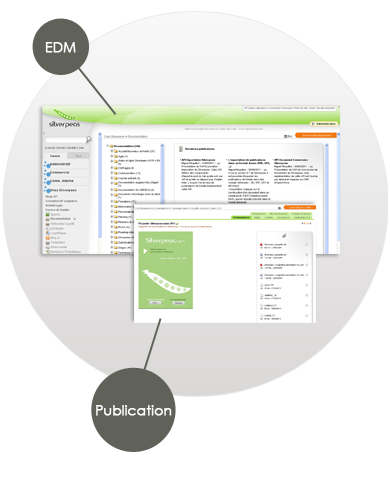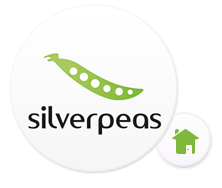Electronic Documentation Management

XML
- The silverpeasTM EDM allows content to be created from an XML form, where a metadata description of the publication is stored.
- The EDM is a complete WYSIWYG Open source editor, which allows text from MS Word to be copied and pasted without the loss of formatting.
Attached files by drag and drop
- Files of any format (MS Office, Pdf etc) can be attached using drag and drop straight onto the web page. This is a simple way of publishing because silverpeasTM can exploit the file properties such as title or author.
Validation workfklow
- A publication can follow a simple validation workflow: Writer –> publisher –> reader
- A more complex workflow with multiple steps and parallel or conditional connections, is of course possible.
Classification
- Publications can also be classified using the classification scheme.
Theme Tracker
- The EDM service is called "Theme tracker", organized by themes and sub-themes.
- All users with authoring rights on a Theme Tracker, can fill in forms, place files and download all types of files.
- Authors can create new publications in each theme with an unlimited number of levels.
- When a file is deposited, it will be automoatically indexed if it not readable by the search engine.
- The following file formats are supported by our search engine: MSOffice, Open Office, text, rtf and html.
- Template creation and modification of form templates is carried out by platform administrators and described in XML.
- An administration tool allows platform administrators to automatically manage new forms.
- The digitalizing system outputs an XML file which is imported into Silverpeas by the same import engine used for the retrieval of basic information.
- Most silverpeasTM services allow information to be pushed. It can be used to notify all or a section of the users of a service.
- The notification engine allows all users to choose a channel through which the alerts will arrive. By default, notifications are sent via email, but there is also an internal notification box at silverpeas.
Life-cycle
Workflow
- By default, the documentation manager allows one level of validation. The workflow engine allows more complex procedures to be deployed. (see Workflow )
Status
- By default, publications in the documentation manager can have 4 types of status:
- Draft
- Awaiting validation
- Validated
- Refused
- In the case of a workflow engine, the status can be defined by the workflow creator.
- The workflow engine allow alerts to be sent if a time-out is reached at any stage. It is also possible to change status.
Publication visibility
- Publications have a visibility start and end date.
- By default, the visibility start date is the date of creation of the publication. By defalut, there is no defined end date.
Indexation and searches
Metadata
- Form settings can be set by the platform administrator via an on-line tool.
- The fields available are: text, text zone, rich text, check boxes, radio buttons, drop-down lists, date, user, url, image and file.
- When a form is defined, it is possible to make the fields required. The design of the form can also be modified using html styles.
- SilverpeasTM allows multiple language use for its forms.
- The choice of form to be associated with a publication can be restricted, according to the place where the information is placed.
Classification and taxonomy
- Silverpeas allows a classification scheme to be common to the whole platform. However; its use can be limited according to the space or service used.
- The classification tree structure is visible in the navigation part of the application or accessible via the search engine.
- The classification scheme is exported in XML format by default.
Indexing
- The SilverpeasTM search engine uses the Lucene Open Source component from the Apache Jakarta project.
- The search function is accessible from the home page and is always available whilst the Silverpeas platform is being used. The search engine also includes a function which recalls the results of the last search.
- The basic search is used to search using a character chain, on the entire contents of the platform data (metadata and attached files).
- The advanced search can be limited to a collaborative space, a service, an author, to publication dates or the axes of the classification scheme.
The search engine
- Searches can be made on a restricted document group via the advanced search interface
- ET, OU and SAUF operators can be used
- Truncation to the right is allowed
- Searching between commas is allowed
These functions are available on the full-text search, as well as for the search fields on a form.
- Searching can be done on pre-defined fields of a form
- Full-text search on attached files is allowed
Requests and results
- The platform can save a request submitted to the search engine.
- Searches can be launched again later with a simple click.
- The list of saved requests is accessible from the personal space or advanced search interface.
- Only the last search result is saved.
